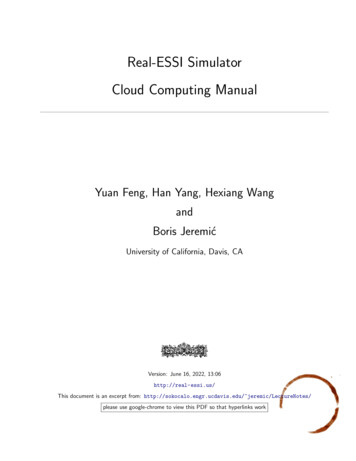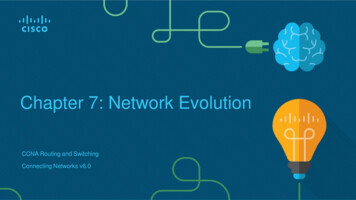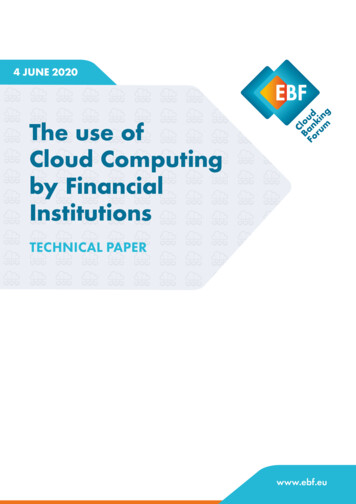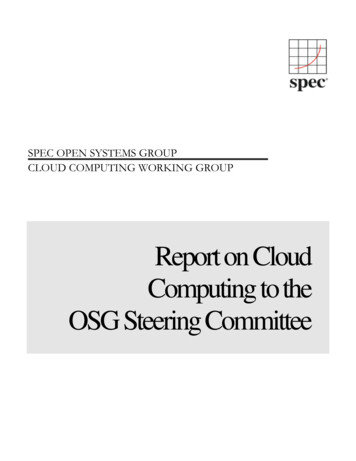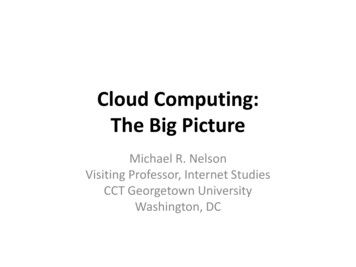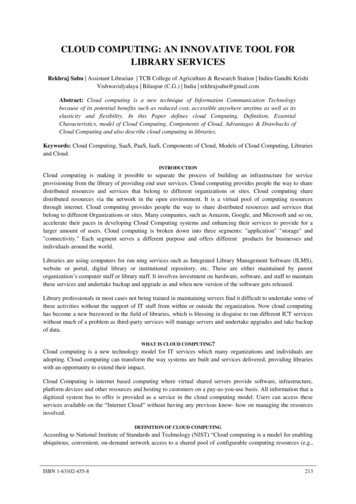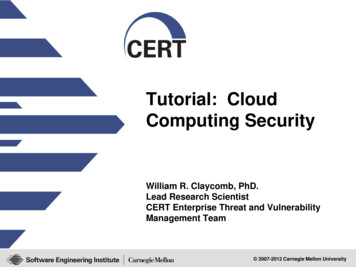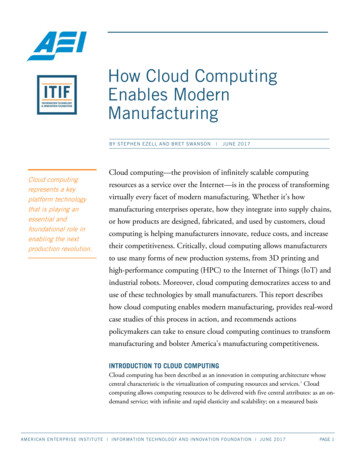
Transcription
How Cloud ComputingEnables ModernManufacturingBY STEPHEN EZELL AND BRET SWANSONCloud computingrepresents a keyplatform technologythat is playing anessential andfoundational role inenabling the nextproduction revolution. JUNE 2017Cloud computing—the provision of infinitely scalable computingresources as a service over the Internet—is in the process of transformingvirtually every facet of modern manufacturing. Whether it’s howmanufacturing enterprises operate, how they integrate into supply chains,or how products are designed, fabricated, and used by customers, cloudcomputing is helping manufacturers innovate, reduce costs, and increasetheir competitiveness. Critically, cloud computing allows manufacturersto use many forms of new production systems, from 3D printing andhigh-performance computing (HPC) to the Internet of Things (IoT) andindustrial robots. Moreover, cloud computing democratizes access to anduse of these technologies by small manufacturers. This report describeshow cloud computing enables modern manufacturing, provides real-wordcase studies of this process in action, and recommends actionspolicymakers can take to ensure cloud computing continues to transformmanufacturing and bolster America’s manufacturing competitiveness.INTRODUCTION TO CLOUD COMPUTINGCloud computing has been described as an innovation in computing architecture whosecentral characteristic is the virtualization of computing resources and services. 1 Cloudcomputing allows computing resources to be delivered with five central attributes: as an ondemand service; with infinite and rapid elasticity and scalability; on a measured basisAMERICAN ENTERPRISE INSTITUTE INFORMATION TECHNOLOGY AND INNOVATION FOUNDATION JUNE 2017PAGE 1
(meaning the service can be billed); through pooled (i.e., shared) resources; and with broadnetwork access. 2Enterprises tend to implement cloud computing in one of three major formats: software asa service (SAAS), platform as a service (PAAS), or infrastructure as a service (IAAS). 3Software as a service—think online productivity software such as Google Docs orSalesforce’s online customer relationship management (CRM) software—allows users toaccess software applications over the Internet using personal computers, mobile devices, orinstrumented machines, instead of having to store software locally on in-house devices. 4Infrastructure as a service gives organizations access to secure, enterprise-class computinginfrastructure that can be infinitely managed and scaled to meet different needs, whetherfor computer processing or data-storage capacity. Finally, platform as a service allows usersto rent virtualized software development or production environments to efficiently developand deploy new applications without having to invest in expensive hardware or softwarelicenses of their own.Cloud computing is a technology model for enabling the delivery of IT resources (i.e.servers, storage, applications, etc.) on demand. Cloud has essential characteristics such ason-demand self-service, resource pooling, and rapid elasticity—giving organizations theability to purchase IT services in a utility-based model, paying for only the servicesconsumed. Cloud also typically is delivered according to one of three service models,namely Software as a Service (SaaS, where the consumer uses a provider’s applicationrunning on cloud infrastructure), Platform as a Service (PaaS, where the consumer can usecloud infrastructure to deploy applications) and Infrastructure as a Service (IaaS, wheretypically the consumer can provision IT resources and run their own systems andapplications on infrastructure offered by a cloud provider). Additionally, cloud computingis usually deployed in one of four different configurations: a public cloud, a hybrid cloud, acommunity cloud or a private cloud. 5HOW CLOUD COMPUTING ENABLES MODERN MANUFACTURINGInformation technology is transforming the global manufacturing economy bydigitizing virtually every facet of modern manufacturing processes—a phenomenoncalled “smart manufacturing” in the United States and “Industry 4.0” in Europe. 6Cloud-based computing, alongside other foundational technologies such as nextgeneration wireless, advanced sensors, high-performance computing, and computeraided design, engineering, and manufacturing (CAD/CAE/CAM) software,represents an essential component of the smart manufacturing revolution.Cloud-computing applications will impact virtually every aspect of modern manufacturingcompanies. At the enterprise level, cloud computing will impact how companies managetheir operations, from enterprise resource planning (ERP) and financial management todata analytics and workforce training. The cloud will also prove integral to howmanufacturers integrate themselves into industrial supply chains. At the manufacturedproduct level, cloud computing will transform everything from how products themselvesAMERICAN ENTERPRISE INSTITUTE INFORMATION TECHNOLOGY AND INNOVATION FOUNDATION JUNE 2017PAGE 2
are researched, designed, and developed, to how they are fabricated and manufactured, tohow they are used by customers in the field. Moreover, cloud computing will play a keyrole toward enabling and democratizing new manufacturing production systems such as3D printing (i.e., additive manufacturing), generative design, and the Industrial Internet ofThings. In fact, digital services such as cloud computing now provide at least 25 percent ofthe total inputs that go into finished manufactured products. 7Digital services suchas cloud computingnow account for atleast 25 percent ofthe total inputs thatgo into finishedmanufacturedproducts.As this report will show, cloud-based solutions offer manufacturers a wide range of benefits,among the most significant of which are: scalability; operational efficiency; application andpartner integration; data storage, management, and analytics; and enhanced security. Inparticular, cloud computing facilitates research, design, and development of new products,which powers innovation, reduces product development costs, and speeds time to market. 8Cloud computing helps manufacturers manage their businesses with better intelligence,which is made possible through expanded use of data analytics. In fact, the cloud is fastbecoming the central venue for data storage, analytics, and intelligence for mostmanufacturers. Cloud computing also empowers manufacturing operations, making themmore productive, cost- and energy-efficient, safe, and streamlined.Cloud-based systems can be scaled up or down to manage shifting project workloads, anespecially important requirement for manufacturing firms. 9 Moreover, cloud computinggives manufacturers the ability to leverage infinitely scalable computational resources on anon-demand, pay-as-you-go basis, so that manufacturers can readily access thecomputational resources they require without having to purchase expensive IT equipmentup-front when they may only need it intermittently. This dynamic levels the playing fieldespecially for small to medium-sized manufacturing enterprises (SMEs) that lack thefinancial wherewithal to purchase expensive IT equipment. This dynamic applies not onlyto hardware, but also to software. In the past, manufacturers of all sizes have had topurchase expensive enterprise-wide licenses for enterprise resource planning software, CRMsoftware, product-design software, etc. But now that same CRM, ERP, or design softwarecan be flexibly consumed as an on-demand, as-needed service, greatly improving enterpriseagility while giving SMEs affordable access to global best-of-breed software.Another key way cloud computing will impact modern manufacturing is by facilitatingintegration—whether of widespread supply chains or of the data streaming from IoTenabled production equipment on the factory floor. 10 Intelligently integrating data streamsfrom myriad partners, platforms, and devices is challenging enough, but is much moredifficult to do inside companies’ own data centers as opposed to in well-networked datacenters operating in the cloud. Finally, cloud computing can actually make manufacturingIT systems more secure. This is because cloud-computing providers employ best-of-breedcybersecurity practices that are often far more sophisticated than what individualcompanies can achieve by themselves on a one-off basis.Noting that “evidence on the productivity effects of adopting cloud applications is scarce,”the economists Haug, Kretschmer, and Strobel have developed a “cloud adaptivenessAMERICAN ENTERPRISE INSTITUTE INFORMATION TECHNOLOGY AND INNOVATION FOUNDATION JUNE 2017PAGE 3
measure” that captures a firm’s technological and organizational readiness to adapt to cloudcomputing. 11 The authors find that “cloud-adaptive manufacturing firms generally exhibithigher average labor productivity compared to manufacturing firms that are not cloudadaptive.” 12 Their analysis further finds that the manufacturing sector has thus far laggedthe services sector in cloud adoption, but they note that this means cloud’s potential in themanufacturing sector may therefore be even greater going forward.With that introduction, this report proceeds by considering how increased investment inIT innovations such as cloud computing can bolster the competitiveness of Americanmanufacturing and by assessing the adoption of cloud computing by manufacturers. Itthen explains specifically how cloud computing is being implemented at themanufacturing-enterprise and manufactured-product levels and presents several in-depthcase studies of large and small manufacturers’ implementations of cloud computing. Itconcludes by offering policy recommendations to expand use of cloud computing in themodern manufacturing economy.AMERICAN MANUFACTURING: FAILURE OR SUCCESS?The state of American manufacturing has become a central question for economics andpolitics. On the one hand, manufacturing is seen as a struggling sector of the economy.Twenty years ago, U.S. manufacturing employed approximately 17 million Americans. Buttoday that number has fallen to just 12 million, a loss of five million jobs. The hollowingout of industry is seen as a significant economic and political problem. Pessimists point toautomation and foreign trade as the culprits, and they contend that in coming years robotsand artificial intelligence will only exacerbate these employment challenges.On the other hand, U.S. manufacturing output today is 40 percent greater than it was twodecades ago. The notion that “America doesn’t make anything anymore,” the optimistsargue, is simply false. Top-line data implies that America makes a lot more things, and itmakes them more efficiently. On the surface, therefore, manufacturing seems like anindustry enjoying rapid productivity gains—lots more output with many fewer workers.The reality is more complex. Many of the productivity gains in manufacturing areconcentrated in just a few sub-sectors, especially in computer and electronicsmanufacturing. Moore’s Law, for example, provides a massive tailwind to manufacturedcomputer goods, where the nature of semiconductor technology itself delivers spectacularquality gains of about 50 percent per year, regardless of labor productivity.Remove Moore’s Law from the equation, however, and the performance of non-technologymanufacturing firms becomes far more mixed. Productivity growth in many manufacturingsectors over the last 15 years has flatlined, or in a few cases even declined. Outside of themanufacturing of technology itself, many manufacturing industries have been struggling.So, lumping all manufacturing together obscures important distinctions among diversesub-sectors—food and pharmaceuticals, furniture and steel, asphalt and airplanes, etc.AMERICAN ENTERPRISE INSTITUTE INFORMATION TECHNOLOGY AND INNOVATION FOUNDATION JUNE 2017PAGE 4
One reason for the huge productivity differentials between industries and firms is the vastgulf in their use of technology. Despite slow productivity growth across the economy overthe last decade, many digital industries, such as media, finance, and professional services,have demonstrated surprisingly robust productivity gains. However, most physicalindustries, such as transportation, health care, and many manufacturing sub-sectors, havenot. Like the other physical industries, many manufacturers have been slower to exploit thepower of information technology to improve design, production, and distribution. Forexample, the capital stock of software held by manufacturers was barely larger in 2014 thanin 2001 (see figure 1). And over the last 20 years, the capital stock of total informationtechnology deployed by non-tech manufacturers has risen just half as much as for allmanufacturers (see figure 2).Index: 1994 1, 2009 U.S. DollarsFigure 1: Manufacturing Software Investment Levels Off 133.02.52.01.51.0Capital Stock of Software in ManufacturingThe “crisis of automation,” which supposedly kills jobs and caps wages, is backwards. Jobsand incomes in firms and industries that use more technology inputs have, more often thannot, been rising faster than in those that use less. For many manufacturing sectors, theproblem is not too much technology, but too little. The physical industries in general, andmany manufacturing firms in particular, have not kept pace with the more innovativedigital economy.There is reason to believe, however, that this is about to change for the better. Ifmanufacturers’ investments in information technology capital have stagnated, they haverecently begun spending far more on infotech services. This new focus on infotech intensitycould signify the beginning of a new era of manufacturing innovation.AMERICAN ENTERPRISE INSTITUTE INFORMATION TECHNOLOGY AND INNOVATION FOUNDATION JUNE 2017PAGE 5
Index: 1994 1, 2009 U.S. DollarsFigure 2: Capital Stock of IT Deployed By Non-Tech Compared to All Manufacturers 142.42.22.01.81.61.41.21.0All ManufacturingManufacturing (Excluding Computers and Electronics)Before the turn of the millennium, U.S. manufacturers were spending around 90 billionper year on information technology goods and services. A significant portion of that likelywas related to fixing anticipated Y2K computer glitches. As many manufacturing sectorsstruggled during the 2000s, technology spending steadily declined, falling to just 64billion at the nadir of the Great Recession.Figure 3: Spending by U.S. Manufacturers on Technology Goods and Services 15Billions of U.S. 5Soon after, however, despite a slow economic recovery, manufacturers began spendingmore on technology. By 2011, IT spending reached a level not seen since 2000, and it keptgoing up, rapidly. In 2015, manufacturers spent 124 billion on information technologyservices, twice the low point of 2009. This sharp increase, seen in figure 3, is the leadingAMERICAN ENTERPRISE INSTITUTE INFORMATION TECHNOLOGY AND INNOVATION FOUNDATION JUNE 2017PAGE 6
edge of the digital revolution in manufacturing and is coincident with the rise of a newarray of user-friendly information tools. It reflects spending on cloud computing andstorage, software as a service, cloud-based design, and the non-investment components ofother digital platforms like supply chains, distribution, customer support, workforcetraining, and the Internet of Things.This increase is good news for productivity—and for workers. Other industries that havemore fully exploited the power of information technology have enjoyed far fasterproductivity, employment, and income growth. These new tools should better equip U.S.firms not only to compete with global manufacturing rivals in existing markets but also torethink the purpose and processes of manufacturing as well as to invent entirely newproducts and manufacturing services.ADOPTION OF CLOUD COMPUTING BY MANUFACTURERSApplications of cloudcomputing inmanufacturingindustries can begrouped into thosethat impact themanufacturingenterprise broadly andthose that impactmanufacturedproducts themselves.Over 90 percent of global enterprises report using cloud computing in some part of theirbusiness. 16 A 2015 study by market research firm IDC surveyed nearly 600 manufacturingenterprises from 17 countries and found that 66 percent of respondents reported using apublic-cloud implementation for two or more applications while 68 percent were using aprivate cloud. 17 The study further found that these manufacturers expected to increase thecloud-services share of their annual IT budgets by 27 percent from 2015 to 2017. 18Moreover, cloud-hosted services are expected to account for nearly half of all organizationlevel software usage among manufacturers by 2023. 19 The market research firm Gartnerestimates that what it calls the “cloud shift”—the transition from spending on traditionalIT offerings to cloud services—will be worth 111 billion in 2016 and will grow to morethan 216 billion in 2020. 20Within the manufacturing sector itself, a study by the Economist Intelligence Unit (EIU)found that 60 percent of survey respondents believe cloud computing will be “veryimportant” in supporting production processes, while 54 percent respond it will be “veryimportant” for better supply chain management, 52 percent believe so for enabling designand prototyping, and 48 percent for inventory, orders, and distribution. 21APPLICATIONS OF CLOUD COMPUTING IN MANUFACTURINGApplications of cloud computing in manufacturing industries can be grouped into thosethat impact the manufacturing enterprise broadly and those that impact the manufacturedproduct itself. For the latter, it includes how the products are researched, designed, anddeveloped; the manufacturing processes and production systems used to manufacture them;and how the products are used, consumed, and maintained post-sale. This section describesexamples of applications of cloud computing at each of these stages.Cloud Computing at the Manufacturing-Enterprise LevelAt the enterprise level, cloud computing broadly supports manufacturing enterprises’operations including through applications such as enterprise resource planning, dataanalysis, and workforce training and management. Cloud computing also supportsmanufacturers’ integration into global supply, production, and value chains.AMERICAN ENTERPRISE INSTITUTE INFORMATION TECHNOLOGY AND INNOVATION FOUNDATION JUNE 2017PAGE 7
Cloud Computing Supports Manufacturing Enterprises’ OperationsManufacturers are increasingly leveraging cloud computing to manage every facet of theirenterprise operations. Consider Mystery Ranch, a medium-sized manufacturer inBozeman, Montana, that specializes in high-end backpacks and other backpackingaccessories. The company leverages cloud-based software to manage virtually every aspectof its operations at five contract-manufacturing locations in the United States, Vietnam,and the Philippines, including design and engineering, production, quality control,research and testing, manufacturing, inventory management, employee management,financials, vendor relations, e-commerce, and sales and marketing. 22 Kendra Clark, MysteryRanch’s IT project manager, explains that the cloud helps the company manage the entireview of its enterprise operations, “providing visibility of consumption of raw materials,time-stamping what products have been completed, and either shipping products direct tocustomers or transferring them here for direct sales.” 23 It’s a succinct example of howmanufacturers are effectively using cloud-based enterprise management resourceplanning solutions.Another example in this vein is manufacturers’ increasing use of cloud-based solutions tosupport enterprise-wide data analytics to improve their manufacturing operations andbetter tailor their products to customers’ specific needs. For instance, large multinationalmanufacturers in the healthcare industry, such as Johnson and Johnson (J&J), areanalyzing big data in the cloud to efficiently drive insights across the enterprise to betterenable decision-making in business and operations. 24 With more than 260 operating unitsacross 65 countries, J&J has data everywhere. As the company’s director of enterprisearchitecture notes, this means, “It’s very difficult for us to bring all the informationtogether in order to make enterprise-wide decisions.”25 Accordingly, the companydeveloped a hybrid-cloud architecture housing over 120 applications to explore its data ona near-real-time basis, at scale, thereby allowing it to identify patterns and relationships andgarner better insights from across the enterprise for everything from maintaininginventories to forecasting new revenue opportunities. 26 “What the cloud has enabled us todo is make sense of that data,” J&J’s chief technology officer explained. “It’s giving us thescale we need to operate and the ability to scale up and scale out. These new clouds incombination with new technologies, such as machine learning, have allowed us to flattenout the time to insight. We’ve decreased provisioning times from three months to under anhour, which is game changing.” 27 This is a good example of how cloud computing ishelping manufacturers gain a more sophisticated, enterprise-wide view of their operations,considerably enhancing their operational efficiency and speeding their time to market.Another important enterprise-wide use of cloud computing pertains to human resourcemanagement and especially to workforce training. Manufacturers are increasinglydelivering realistic, just-in-time training through cloud-enabled devices. 28 For instance,cloud-hosted resources can serve as the back end for training programs that use graphicintensive virtual reality to simulate real-world scenarios and conditions. Elsewhere, cloudbased learning management systems can automate manufacturers’ training processes fromAMERICAN ENTERPRISE INSTITUTE INFORMATION TECHNOLOGY AND INNOVATION FOUNDATION JUNE 2017PAGE 8
content development and course registration through to course completions, testing,assessment, and certification. 29For instance, Tooling U-SME, a web-based, cloud-delivered, massively open online course(MOOC) provides over 500 online classes related to manufacturing technology, breakingdown the training into nine functional areas and 60 competency models to identify gaps,define requirements, and provide specific guidance for development. 30 Tooling U-SME’s“Accelerate Methodology” provides a comprehensive, structured, enterprise-specificapproach that helps manufacturers and their workers acquire needed skills. Similarly, inChicago, Illinois, the Digital Manufacturing and Design Innovation Institute (DMDII),one of the 14 Institutes of Manufacturing Innovation that comprise the federally supportedManufacturing USA network, has developed a Coursera-hosted MOOC that’s teachingessential skills related to digital manufacturing and design technologies. 31Cloud Computing Supports Manufacturing Supply Chain IntegrationBy elevating digitalinteractions aboveenterprises’ ownproprietary datacenters, cloudcomputing plays apivotal role infacilitatingenterprises’integration intobroader industrialsupply chains.By elevating digital interactions above enterprises’ own proprietary data centers and intothe cloud, cloud computing will play a pivotal role in facilitating enterprises’ integrationinto broader industrial supply chains. Indeed, cloud computing platforms are becomingmore pervasive in large-scale supply chains as enterprises look to gain agility and speed inresolving complex problems through more effective collaboration. (In fact, 46 percent ofrespondents to a 2012 SCM World Survey contended that greater supply chaincollaboration leads to problems being solved twice as fast. 32) As Accenture observes, “Cloudcomputing is increasingly the engine that makes supply chains talk to each other.” 33 Formanufacturers, cloud-based supply-chain management solutions can deliver a number ofspecific benefits, such as: permitting the integration of multiple IT platforms, providing anenvironment for collaboration, supporting integrated advanced analytics, and increasingscale and reducing costs. 34 It’s expected that supply-chain management solutions deliveredvia software as a service will constitute a 4.4 billion market by 2018, representing morethan three-fold growth since 2012. 35As an example, drug-maker Pfizer has leveraged cloud computing to completely reengineerits complex global supply chain, moving its supply chain fully into the cloud andintroducing a new virtualized layer that delivers common information to all participants. 36Instead of insisting that partners implement Pfizer’s own ERP system, the companyrequested that more than 500 suppliers implement a cloud-based common-informationexchange framework, with each supplier represented as a node on a virtual supply chain. 37Jim Cafone, Pfizer’s vice president of supply network services, describes this approach asconnecting “supply-neutral devices using an information architecture that includes cloudbased processes and information layers sitting above physical assets and supply chains as away to manage the company’s end-to-end networks in a ‘device-dependent’ fashion.” 38Cafone further notes that this supply chain virtualization has enabled Pfizer to respondmuch faster to unexpected events that might otherwise disrupt its complex supply chain.This has also made it possible for Pfizer to enter global markets much more efficiently. AsCafone explains, the approach enables Pfizer “to land products into portions of the worldAMERICAN ENTERPRISE INSTITUTE INFORMATION TECHNOLOGY AND INNOVATION FOUNDATION JUNE 2017PAGE 9
where before we and the rest of the industry were flying blind. For example, we know whena product lands [i.e., arrives] in Kenya or anywhere else in the world, because we have thattraceability.” 39 Cafone observed that Pfizer’s cloud-based supply chain managementsolution has allowed it to move in 18 months from an environment of “zero shipmenttraceability” to a device-independent platform that has already handled more than 40,000global shipments. 40Cloud Computing at the Manufactured-Product LevelBeyond the manufacturing-enterprise level, cloud computing will exert a tremendousimpact on how manufactured products themselves are designed, fabricated, and used. Inparticular, the cloud enables a range of advanced manufacturing production systemssuch as 3D printing, the Internet of Things, high-performance computing, andindustrial robotics.Cloud Computing Enables Design and Development of Manufactured ProductsCloud-hosted,computer-aideddesign tools arestreamlining productdevelopmentprocesses, speedinginnovation cycles, andaccelerating timeto market.Traditionally, product design in manufacturing was all about creating physical prototypes,testing or experimenting with them, and then going through an iterative refinementprocess until reaching a final product. But, increasingly, cloud-hosted, computer-aideddesign tools are streamlining product-development processes, speeding innovation cycles,and accelerating time to market. Cloud computing allows computer-aided design,engineering, and manufacturing (CAD/CAE/CAM) to be performed on high-poweredsupercomputers, meaning designers and engineers no longer have to rely on powerfulmachines in their office or per-seat software licenses to run ground-breaking simulations orcreate data-intensive designs. Cloud computing provides the immense data capacity andvirtualized computing power to enable this dynamic, digitally based design. 41 And bycentralizing and bringing all that data into the cloud, engineers can have the same plansavailable to them across any device. 42Cloud computing is also enabling “generative design,” a technique that mimics nature’sevolutionary approach, in which engineers enter design goals into software, along withparameters such as materials, manufacturing methods, and cost constraints, and thesoftware algorithmically explores all possible permutations of a solution. By leveragingcloud computing, generative-design software can quickly cycle through thousands—oreven millions—of design choices, testing configurations, and learning from each iterationwhat works and what doesn’t. 43 Generative-design software regularly returns products thatare more efficient, better optimized, stronger, lighter weight, and more durable thandesigners could ever before have foreseen or imagined. 44 The application of generativedesign can be used not just for individual parts, but also multiple parts in an assembly, themanufacturing operations on individual machines making these parts, processes acrossseveral manufacturing machines, factories across several production lines, or even supplychains across multiple factories.For instance, Airbus used generative-design techniques to design a new aircraft bulwark(see figure 4). This so-called bionic partition was developed with a pioneering combinationAMERICAN ENTERPRISE INSTITUTE INFORMATION TECHNOLOGY AND INNOVATION FOUNDATION JUNE 2017PAGE 10
of generative design, 3D printing, and advanced materials. It is almost 50 percent lighterthan current aircraft bulwark partition designs, yet far stronger. 45Figure 4: Aircraft Bulwark Conceptualized Via Generative Design Techniques 46Cloud computing is now a sine qua non in the design shops of all major automotivemanufacturers, in part because creating innovative automotive designs almost always entailsa collaboration among designers, engineers, supply chain experts, and production andservices organizations. Cloud-based platforms are particularly well suited to allowing suchcross-functional teams to work on new designs in real time, sharing information to speedup innovation. Further, as Forbes’ Louis Columbus explains, “the cloud helps to eliminateinformation silos that used to keep auto makers bogged down with delays and errors. Bysharing more data, more often, automak
Cloud computing has been described as an innovation in computing architecture whose central characteristic is the virtualization of computing resources and services. 1 Cloud . Cloud-computing applications will impact virtually every aspect of modern manufacturing companies. At the enterprise level, cloud computing will impact how companies manage




